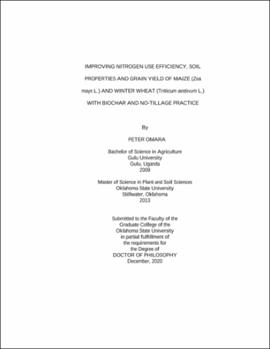| dc.contributor.advisor | Raun, William R. | |
| dc.contributor.author | Omara, Peter | |
| dc.date.accessioned | 2021-05-25T20:32:10Z | |
| dc.date.available | 2021-05-25T20:32:10Z | |
| dc.date.issued | 2020-12 | |
| dc.identifier.uri | https://hdl.handle.net/11244/329925 | |
| dc.description.abstract | The first study (chapter 1) of this dissertation was conducted to establish possible synergies in applying inorganic fertilizer nitrogen (N) in combination with biochar (NBC) and the subsequent role in optimizing maize (Zea mays L.) grain yield, N use efficiency (NUE), and soil chemical properties. Field trials were conducted in 2018 and 2019 at Efaw and Lake Carl Blackwell (LCB) both located near Stillwater, Oklahoma. Results from this study showed an overall positive effect of NBC on grain yield, NUE, and soil properties relative to inorganic fertilizer N applied solely. However, the positive observation was not consistent across experimental locations. While results were inconsistent, the significant response to NBC was evident at LCB with a fine sandy loam soil but not at Efaw with silty clay loam. Therefore, application of biochar in combination with inorganic N could improve soil properties, NUE and grain yield of maize cultivated on coarse textured sandy soils with poor chemical properties compared to soils with fine texture. | |
| dc.description.abstract | The second chapter of this dissertation used data from long-term continuous winter wheat (Triticum aestivum L.) experiments to compare the change from conventional tillage (CT) to no-tillage (NT) on grain yield, NUE, and soil properties. Experiments 222 at Stillwater and 502 at Lahoma, Oklahoma established in 1969 and 1970, respectively were used. Both experiments were managed under CT until 2010 and changed to NT in 2011. Results from this study showed significant impact of changing winter wheat production from CT to NT. However, positive results were not consistent across experimental locations. No-tillage advantages were only observed in comparatively shallow soil. Overall, it is evident from this study that NT positively influences grain yield, NUE, and soil properties. Therefore, NT is likely a sustainable long-term strategy for improving soil quality and crop productivity in a continuous mono-cropping system. | |
| dc.format | application/pdf | |
| dc.language | en_US | |
| dc.rights | Copyright is held by the author who has granted the Oklahoma State University Library the non-exclusive right to share this material in its institutional repository. Contact Digital Library Services at lib-dls@okstate.edu or 405-744-9161 for the permission policy on the use, reproduction or distribution of this material. | |
| dc.title | Improving nitrogen use efficiency, soil properties and grain yield of maize (Zea mays L.) and winter wheat (Triticum aestivum L.) with biochar and no-tillage practice | |
| dc.contributor.committeeMember | Zhang, Hailin | |
| dc.contributor.committeeMember | Weckler, Paul | |
| dc.contributor.committeeMember | Arnall, D. Brian | |
| osu.filename | Omara_okstate_0664D_16909.pdf | |
| osu.accesstype | Open Access | |
| dc.type.genre | Dissertation | |
| dc.type.material | Text | |
| dc.subject.keywords | biochar | |
| dc.subject.keywords | fertilizer management | |
| dc.subject.keywords | nitrogen use efficiency | |
| dc.subject.keywords | no-tillage | |
| dc.subject.keywords | soil properties | |
| thesis.degree.discipline | Soil Science | |
| thesis.degree.grantor | Oklahoma State University | |
